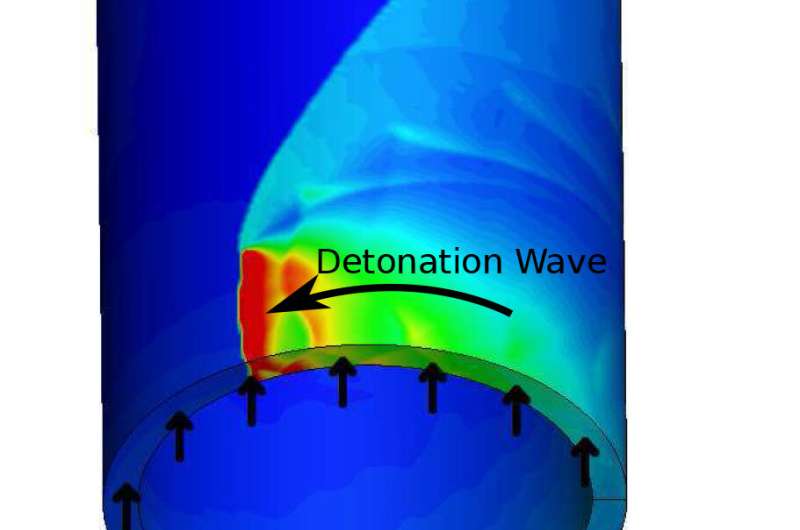Physicists find way to control detonation wave in promising new type of engine

Skoltech researchers have theoretically predicted synchronization—a kind of self-regulation—in detonation waves. The discovery could help tame this inherently chaotic process so as to stabilize combustion in a rotating detonation engine. This refers to an experimental device potentially conserving vast amounts of fuel compared with conventional rocket and ship engines. The study came out in the Journal of Fluid Mechanics.
Detonation is a kind of combustion that involves reaction products propagating at supersonic speeds, which in theory would make better use of fuel. Researchers are exploring the concept of the detonation engine in the hope of ultimately achieving a 25% boost in efficiency.
"In a rotating detonation engine, one cylinder fits within another, larger cylinder, creating a space between the two for the combustible mixture to be injected into. The mixture continuously detonates, with the detonation wave traveling in circles around the smaller cylinder. However, due to the chaotic nature of the process, the detonation wave will not behave in a perfectly regular way one cycle after another. The very velocity of its propagation is prone to unpredictable oscillations, making the engine unstable," the study's principal investigator and Skoltech Associate Professor Aslan Kasimov commented.
His team has discovered a way to tame the detonation wave, equalizing its oscillations. To that end, the researchers deliver the first theoretical demonstration of synchronization in a detonation process.
What is synchronization?
Synchronization was originally discovered as a phenomenon of mechanics by Huygens in the 17th century. He was observing a pair of pendulum clocks hanging from the same beam and noticed that over time, this extremely subtle connection between the clocks resulted in their pendulums swinging either in phase or in anti-phase. Since then, synchronization was discovered in a wide range of areas of chemistry, medicine, biology, and even sociology.
"For example, there are some fireflies that flash with a certain frequency. When a large number of them gather in one place, they start flashing in sync despite only having a weak connection: Each beetle can only see its nearest neighbors," the first author of the paper, Skoltech Ph.D. student Andrei Goldin, said before giving more examples.
According to the researcher, the natural biorhythm of a person might have periodicity different from 24 hours, which is clear from experiments placing test subjects in an artificial environment without night and day. The fact that periodic external stimuli in the form of the daily progression from sunrise to noon to sundown regulate the internal rhythms of humans and other animals to conform with the 24-hour cycle is also a case of synchronization.
A cardiac pacemaker is another example of a periodic external stimulus that, in this case, regularizes the internal oscillations of the heart, overcoming arrhythmia.
Beyond that, the framework of synchronization has been applied to the moon facing the Earth with the same hemisphere at all times and even to how the number of serial killer victims varies by date.
In their new paper, Skoltech scientists offer the first-ever demonstration of synchronization with respect to a detonation wave.
Synchronization in detonation
The nature of the detonation process is such that even in a perfectly homogeneous medium, a detonation wave propagates "in fits and starts"—with a variable velocity. This means that the wave itself is an oscillator analogous to the heart with arrhythmia in the above example. Arrhythmia in this case refers to the unpredictable manner in which the wave's velocity oscillates. Recall that this is precisely the problem that makes the detonation engine unstable.
"As it turns out, detonation wave oscillations can be regularized with a periodic external stimulus, but it won't be a stimulus in the conventional sense. Rather, it refers to highly regular inhomogeneities in the medium. That is, in the combustible mixture injected into the space between the engine cylinders. You can think of these inhomogeneities as a pattern of areas—some filled with fuel, some with air—at regular intervals," Kasimov said. "By varying engine design, such as the intervals between the adjacent fuel injectors, you can vary the characteristic size of the inhomogeneities encountered by the propagating detonation wave."
The Skoltech researchers found that complex internal oscillations of a detonation wave can be regularized by virtue of synchronization with the "oscillations" (periodic inhomogeneities) of the medium. Having examined a wide range of potential characteristic sizes of such inhomogeneities, the team discovered certain ranges within which the oscillations of a given detonation wave undergo regularization. That is, the wave still propagates by fits and starts, but these fits and starts become quite predictable.
Owing to their peculiar shape on the graph, all such ranges promoting regularization are collectively referred to as Arnold's tongues, and the paper in the Journal of Fluid Mechanics is the first to describe them with regard to detonation.
The discovery of synchronization and Arnold's tongues in detonation waves lays the foundation for further research into engine designs that would enable engineers to tame the detonation wave and control its propagation velocity. So far the researchers have done the calculations in one dimension, but three-dimensional calculations are necessary for understanding the processes in an actual engine.
More information: Andrei Yu. Goldin et al, Synchronization of detonations: Arnold tongues and devil's staircases, Journal of Fluid Mechanics (2022). DOI: 10.1017/jfm.2022.581
Journal information: Journal of Fluid Mechanics
Provided by Skolkovo Institute of Science and Technology




















